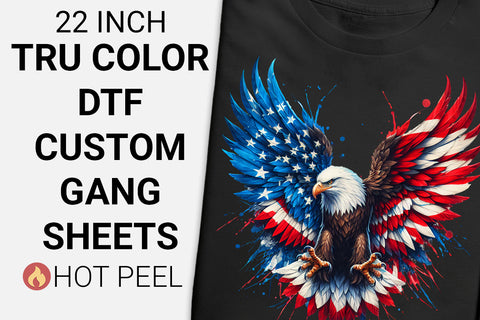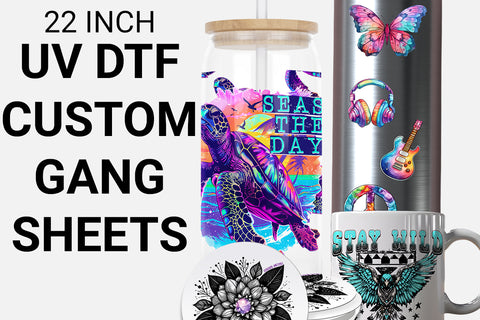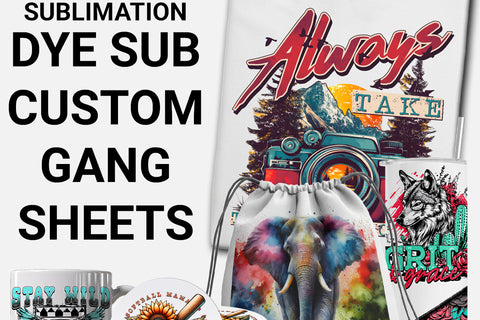Are DTF and screen printing the same thing? Almost. They both transfer ink onto fabric, but they take entirely different paths to get there.
Knowing the difference between these two types of printing methods will be the way you'll be able to determine which would work best for your business or brand.
In this DTF vs screen printing guide, We'll cover everything from set-up to cost to quality and more so you'll be able to figure out what will work best for your business or brand.

Key Takeaways
-
DTF printing is done using film transfers and heat presses, while screen printing is done using mesh screens and multiple layers of ink.
-
DTF is best used for detail-oriented printing with lots of colors and smaller batches.
-
Screen printing is better suited for big volume jobs that require bold and eye-catching results.
-
While DTF printing has lower startup costs and is less expensive per unit for smaller runs, screen printing becomes more cost-effective for huge quantities.
-
DTF printing works with almost every type of fabric available, while screen printing works best on cottons and cotton blends.
What Is DTF Printing?
Think of DTF printing like digital artwork that jumps straight onto fabric.
DTF printing begins with printing the design onto a PET film using CMYK and white ink. Once printed, a glue layer (adhesive powder) is applied to the PET film and then cured. Next, the PET film is placed on the garment and the image is melted into the fabric using a heat press.
DTF Advantages:
- DTF printing produces high-quality, full-color, gradient-based images.
- DTF can be used on a variety of fabrics (light, dark, and textured).
- DTF does not require screens or preparation before printing; simply print and apply heat.
- DTF produces high-quality, long-lasting results.
When it comes to on-demand printing, running smaller quantities of orders, or printing detailed, multi-colored designs, DTF printing is the most popular choice. Think of cozy Gildan hoodies, soft cotton tees, stylish crewneck sweatshirts, and even sleek insulated travel mugs — all ready to showcase vibrant, long-lasting prints.
What Is Screen Printing?
Screen printing is the OG of garment decoration — classic, durable, and bold.
Screen printing has been the oldest method of apparel printing for many years.
It requires creating a separate stencil (screen) for each color of ink. Ink is then pushed through each screen layer onto the shirt and then cured with heat. The more colors you want to print, the more screens you will need.
Screen Printing Advantages:
- Thick, vibrant prints are produced using screen printing and have a textured finish.
- Screen printing is ideal for large-scale bulk production.
- Screen printing provides extremely durable products.
- Screen printing is best for bold, simple designs.
As such, screen printing is an industry standard for producing merchandise, team uniforms, and bulk apparel printing.
What’s the Difference Between DTF and Screen Printing?
Here’s how they stack up side by side:
| Category | DTF (Direct-to-Film Printing) | Screen Printing |
|---|---|---|
| Quality | Produces high-definition, full-color prints with sharp details and vibrant tones. Ideal for photo-like, intricate, or gradient-heavy designs. | Creates bold, solid-color prints with a slightly raised texture. Great for simple logos and strong color blocks. |
| Durability | Built to last through dozens of washes. The print bonds securely with the fabric surface but may have a slightly different “hand feel” compared to ink-based prints. | Extremely durable — ink embeds deep into fabric fibers. Can last for years without cracking or fading, even with heavy wear. |
| Design Complexity | Handles multi-color, detailed, and gradient designs effortlessly. No limit to color count since it’s digital. | Best for bold, minimal designs. Each color needs a separate screen, making complex artwork slower and costlier. |
| Fabric Compatibility | Works on almost any material: cotton, polyester, blends, spandex, nylon, canvas, leather, and textured fabrics. | Performs best on cotton and cotton blends. Requires special inks and prep for synthetics or dark-colored fabrics. |
| Sustainability | Uses less water and no chemical screen prep. However, DTF films and adhesives add some plastic waste. | Requires more water and chemical cleanup, but uses less plastic. Water-based screen inks offer more eco-friendly options. |
| Setup and Equipment | Minimal setup — no screens, emulsion, or drying racks. You only need a printer, powder shaker, and heat press. | Requires multiple screens, inks, a press, curing equipment, and more labor time. Longer prep before printing begins. |
| Minimum Order | No minimums. Print one shirt or a hundred with no extra setup cost. Perfect for custom orders and one-offs. | Higher setup costs make it best for bulk runs (usually 50–100+ pieces). Not cost-effective for small batches. |
| Production Time | Fast turnaround. Digital workflow means prints can be produced and pressed same-day. | Slower setup and drying between layers. Once running, can print large quantities quickly. |
| Average Cost | Most cost-effective for small or mid-size orders due to low setup fees. Price per piece stays consistent. | More expensive to start, but cheaper per unit when printing in high volumes. Ideal for large-scale production. |
| Texture / Feel | Smooth, flexible, and soft-to-touch surface. Feels similar to vinyl but thinner and more breathable. | Slightly raised “ink feel” with a heavier texture. Classic look often preferred for traditional branding. |
| Color Range | Unlimited — full CMYK + white underbase supports millions of color combinations. Excellent for gradients and digital art. | Limited to solid Pantone-style colors. Adding more colors increases time and cost. |
| Turnaround Speed | Extremely fast for one-offs or short runs. Digital printing requires zero downtime between color changes. | Slower for setup, but once running, prints hundreds of pieces efficiently. Great for ongoing bulk projects. |
| Scalability | Scales easily from small runs to medium production. No special prep or equipment changes needed. | Highly efficient for large, repetitive orders but inefficient for frequent small runs or design changes. |
| Maintenance | Low maintenance. DTF printers and presses require routine cleaning but minimal mess or chemicals. | Higher maintenance. Screens, emulsions, and squeegees need regular cleaning and handling. |
| Best Use Case | Custom apparel shops, on-demand businesses, and creators who need full-color designs on diverse fabrics. | Large clothing brands, merch lines, and events that print in bulk using simple, bold graphics. |
DTF vs Screen Printing for Businesses and Brands
Running a business means balancing setup costs, speed, and quality. Here’s what matters most:
Setup and Running Costs
Screen Printing has a bigger setup investment.
Each color in your design needs its own screen — plus ink, prep time, and cleanup. More colors mean more time, space, and cost. It’s great for big runs but less efficient for short jobs or frequent design changes.
DTF Printing keeps things easy.
You just print the design on film, apply adhesive powder, cure, and press. No screens. No alignment stress. No cleanup chaos.
If you’re doing small batches or custom orders, DTF helps you save time and make profit faster.
-
🟢 DTF: Low setup, fast turnaround, budget-friendly for small runs.
-
🟠 Screen Printing: Higher setup, ideal for bulk production.
Versatility
DTF works on almost everything — cotton, polyester, blends, nylon, spandex, canvas, even leather. No pretreatment or ink swap needed. That’s a huge win for shops or brands printing across different products.
Screen Printing prefers cotton or cotton blends.
It struggles with dark or synthetic fabrics unless you use special inks and extra prep steps.
-
🟢 DTF: All-fabric compatible.
-
🟠 Screen Printing: Limited to certain fabrics.
Turnaround Time
If speed matters, DTF wins hands down.
It’s a fully digital process — no screen setup or drying between colors. You can print and press within minutes, making it perfect for same-day fulfillment or quick-turn custom jobs.
Screen Printing needs more time to prepare.
Every color requires its own screen and setup, so small runs can be slow. But once it’s ready, it’s efficient for high-volume production.
-
🟢 DTF: Fast, flexible, and perfect for on-demand printing.
-
🟠 Screen Printing: Slower prep, faster once running in bulk.
Durability
Both methods produce tough, long-lasting prints — just in different ways.
Screen Printing embeds ink directly into the fabric. Once cured, it becomes part of the garment, making it one of the most durable print methods out there. Perfect for uniforms, workwear, and heavy-use apparel.
DTF bonds the design onto the surface using a strong adhesive layer. When applied and cared for properly, it doesn’t crack, peel, or fade — even after dozens of washes.
Quick Take:
-
🟢 DTF: Flexible and durable for everyday wear.
-
🟠 Screen Printing: Slightly stronger for high-wear garments.
Quality of Print
DTF delivers crisp, high-definition results with smooth gradients and photo-quality color. It’s perfect for detailed designs, small text, or complex artwork that needs precision.
Screen Printing gives a bold, textured look that pops. It’s rich, vibrant, and slightly raised — a style that feels classic and handcrafted.
-
🟢 DTF: Sharp, detailed, and modern.
-
🟠 Screen Printing: Bold, vibrant, and timeless.
Color Reproduction
DTF uses a CMYK + white ink system, which can reproduce millions of colors in one pass. That means no limits — gradients, shadows, and full-color artwork all print perfectly.
Screen Printing requires a separate screen for every color. More colors mean more prep, which makes it less practical for detailed or photo-realistic prints.
Quick Take:
-
🟢 DTF: Full-color, photo-quality capability.
-
🟠 Screen Printing: Best for simple logos and limited palettes.
Ink Types
DTF runs on water-based pigment inks — eco-friendly, soft, and vibrant. They sit smoothly on the fabric and work on both light and dark garments.
Screen Printing typically uses plastisol inks — thick, petroleum-based, and extremely durable. They create that raised texture but can feel heavier on the shirt. Some printers use water-based screen inks for a softer, eco option, but they take longer to cure.
-
🟢 DTF: Clean, consistent, and modern.
-
🟠 Screen Printing: Classic, durable, and textured.
Which Is Better Between DTF and Screen Printing?
Whether you choose to do DTF printing or screen printing depends upon the type of print job you're going to be doing as well as the quantity and speed of production needed.
If you need to produce small-quantity, complex, multi-color prints, DTF is clearly the winner.
If you need to produce large bulk simple, clean graphics orders, screen printing will ultimately provide a lower cost-per-piece for you.
We at DTF Virginia had experience with both processes; and while screen printing is great for established companies that want to produce massive amounts of product at an extremely low cost; DTF printing is by far the most versatile, fastest and accurate way to print today.
When you're ready to start printing smarter, looking sharper and getting it done quicker than ever before - our premium DTF transfers from DTF Virginia are ready to bring your creative vision to life - just apply the heat.
DTF vs Screen Printing: Frequently Asked Questions
What lasts longer, Screen Print or DTF?
Screen printing lasts longer overall because the ink penetrates the fabric. But DTF holds up extremely well, often lasting through dozens of washes when pressed correctly.
What are the disadvantages of DTF?
DTF can have a slightly different texture than screen prints, needs film and adhesive powder, and may lose durability if not pressed properly. Still, it’s faster and more versatile for most projects.
What is the difference between Screen Print and Direct Transfer (DTF)?
Screen printing pushes ink directly through a stencil onto fabric.
DTF (Direct-to-Film) prints the design on film and heat-presses it onto the garment — faster setup, smoother finish, and no color limits.
Is DTF ink the same as Screen Printing ink?
No. DTF uses water-based pigment inks, while screen printing uses plastisol or water-based inks pushed through screens. They produce different textures and curing processes.

























